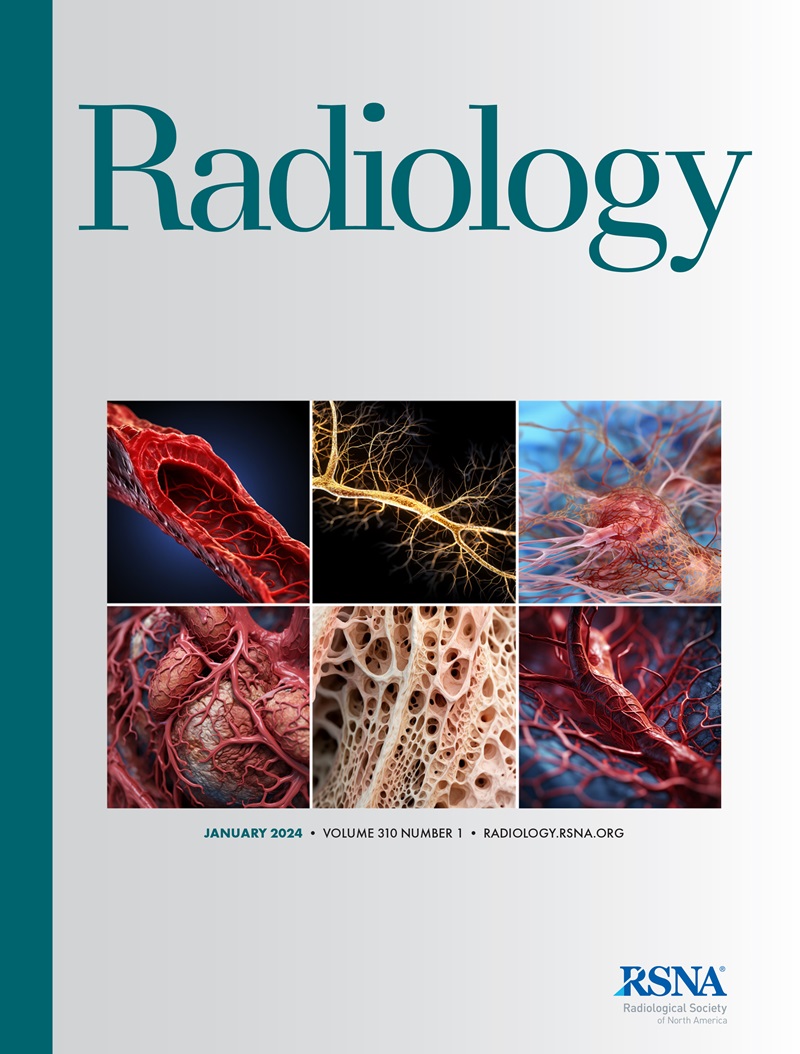Photon-Counting CT Effects on Sensitivity for Liver Lesion Detection: A Reader Study Using Virtual Imaging.
IF 12.1
1区 医学
Q1 RADIOLOGY, NUCLEAR MEDICINE & MEDICAL IMAGING
Benjamin Wildman-Tobriner, Nicholas Felice, Kevin R Kalisz, Brian C Allen, Sarah P Thomas, Danielle E Kruse, William Paul Segars, Brian Harrawood, Mustafa R Bashir, Daniele Marin, Samantha Morrison, Alaattin Erkanli, Ehsan Samei, Ehsan Abadi
下载PDF
{"title":"Photon-Counting CT Effects on Sensitivity for Liver Lesion Detection: A Reader Study Using Virtual Imaging.","authors":"Benjamin Wildman-Tobriner, Nicholas Felice, Kevin R Kalisz, Brian C Allen, Sarah P Thomas, Danielle E Kruse, William Paul Segars, Brian Harrawood, Mustafa R Bashir, Daniele Marin, Samantha Morrison, Alaattin Erkanli, Ehsan Samei, Ehsan Abadi","doi":"10.1148/radiol.241568","DOIUrl":null,"url":null,"abstract":"<p><p>Background Detection of hepatic metastases at CT is a daily task in radiology departments that influences medical and surgical treatment strategies for oncology patients. Purpose To compare simulated photon-counting CT (PCCT) with energy-integrating detector (EID) CT for the detection of small liver lesions. Materials and Methods In this reader study (July to December 2023), a virtual imaging framework was used with 50 anthropomorphic phantoms and 183 generated liver lesions (one to six lesions per phantom, 0.4-1.5 cm in diameter). Virtual CT platforms simulated PCCT and EID CT scanners. Phantoms were virtually scanned using routine (6 mGy) and low-dose (1.5 mGy) conditions and reconstructed with three kernels. A subset of 300 scans (150 PCCT vs EID CT pairs) were selected. Four radiologists independently reviewed all scans to mark liver lesions, assigned confidence scores for detection, and rated scan quality. Analysis was performed on a per-lesion basis to determine sensitivity for several variables and on a per-scan basis for scan quality. The McNemar test, two-sided paired <i>t</i> tests, and mixed-effects logistic regression models were fitted; <i>P</i> < .05 was considered indicative of statistically significant difference. Results Consensus reader sensitivity in detecting lesions was 82.1% (451 of 549) for PCCT versus 77.6% (426 of 549) for EID CT (<i>P</i> < .001), with a mean sensitivity gain of 4.3 percentage points ± 1.3 (<i>P</i> < .001 to <i>P</i> = .02 per reader). Readers had better subjective confidence for lesions at PCCT (mean score, 61.5 ± 22 vs 56.1 ± 24 [on a 101-point scale]; <i>P</i> < .001). Sensitivity was lower for lesions smaller than 1 cm, with more pronounced difference between PCCT and EID CT (74.0% [271 of 366] vs 67.2% [246 of 366]; <i>P</i> < .001). At the lower dose level, PCCT showed higher sensitivity than EID CT (68.9% [168 of 244] vs 61.1% [149 of 244]; <i>P</i> < .001) for subcentimeter lesions. In a multivariable model, PCCT was independently associated with increased odds of lesion detection (odds ratio, 1.55; <i>P</i> < .001). Image quality was slightly higher for PCCT (mean score, 55.3 vs 50.6 [on a 101-point scale]; <i>P</i> < .001). Conclusion Compared with EID CT, PCCT showed better sensitivity in the detection of small liver lesions. © RSNA, 2025 <i>Supplemental material is available for this article.</i> See also the editorial by Menu in this issue.</p>","PeriodicalId":20896,"journal":{"name":"Radiology","volume":"314 1","pages":"e241568"},"PeriodicalIF":12.1000,"publicationDate":"2025-01-01","publicationTypes":"Journal Article","fieldsOfStudy":null,"isOpenAccess":false,"openAccessPdf":"https://www.ncbi.nlm.nih.gov/pmc/articles/PMC11783162/pdf/","citationCount":"0","resultStr":null,"platform":"Semanticscholar","paperid":null,"PeriodicalName":"Radiology","FirstCategoryId":"3","ListUrlMain":"https://doi.org/10.1148/radiol.241568","RegionNum":1,"RegionCategory":"医学","ArticlePicture":[],"TitleCN":null,"AbstractTextCN":null,"PMCID":null,"EPubDate":"","PubModel":"","JCR":"Q1","JCRName":"RADIOLOGY, NUCLEAR MEDICINE & MEDICAL IMAGING","Score":null,"Total":0}
引用次数: 0
引用
批量引用
Abstract
Background Detection of hepatic metastases at CT is a daily task in radiology departments that influences medical and surgical treatment strategies for oncology patients. Purpose To compare simulated photon-counting CT (PCCT) with energy-integrating detector (EID) CT for the detection of small liver lesions. Materials and Methods In this reader study (July to December 2023), a virtual imaging framework was used with 50 anthropomorphic phantoms and 183 generated liver lesions (one to six lesions per phantom, 0.4-1.5 cm in diameter). Virtual CT platforms simulated PCCT and EID CT scanners. Phantoms were virtually scanned using routine (6 mGy) and low-dose (1.5 mGy) conditions and reconstructed with three kernels. A subset of 300 scans (150 PCCT vs EID CT pairs) were selected. Four radiologists independently reviewed all scans to mark liver lesions, assigned confidence scores for detection, and rated scan quality. Analysis was performed on a per-lesion basis to determine sensitivity for several variables and on a per-scan basis for scan quality. The McNemar test, two-sided paired t tests, and mixed-effects logistic regression models were fitted; P < .05 was considered indicative of statistically significant difference. Results Consensus reader sensitivity in detecting lesions was 82.1% (451 of 549) for PCCT versus 77.6% (426 of 549) for EID CT (P < .001), with a mean sensitivity gain of 4.3 percentage points ± 1.3 (P < .001 to P = .02 per reader). Readers had better subjective confidence for lesions at PCCT (mean score, 61.5 ± 22 vs 56.1 ± 24 [on a 101-point scale]; P < .001). Sensitivity was lower for lesions smaller than 1 cm, with more pronounced difference between PCCT and EID CT (74.0% [271 of 366] vs 67.2% [246 of 366]; P < .001). At the lower dose level, PCCT showed higher sensitivity than EID CT (68.9% [168 of 244] vs 61.1% [149 of 244]; P < .001) for subcentimeter lesions. In a multivariable model, PCCT was independently associated with increased odds of lesion detection (odds ratio, 1.55; P < .001). Image quality was slightly higher for PCCT (mean score, 55.3 vs 50.6 [on a 101-point scale]; P < .001). Conclusion Compared with EID CT, PCCT showed better sensitivity in the detection of small liver lesions. © RSNA, 2025 Supplemental material is available for this article. See also the editorial by Menu in this issue.
光子计数CT对肝脏病变检测灵敏度的影响:使用虚拟成像的阅读器研究。
背景:CT检测肝转移是放射科的日常工作,影响着肿瘤患者的内科和外科治疗策略。目的比较模拟光子计数CT (PCCT)与能量积分检测器(EID) CT对肝脏小病变的检测效果。在这项读者研究(2023年7月至12月)中,使用虚拟成像框架对50个拟人化幻影和183个产生的肝脏病变(每个幻影1至6个病变,直径0.4-1.5 cm)进行了研究。虚拟CT平台模拟了PCCT和EID CT扫描仪。在常规(6 mGy)和低剂量(1.5 mGy)条件下对幻影进行虚拟扫描,并用三个核重建。选择300次扫描的子集(150对PCCT vs EID CT)。四名放射科医生独立审查所有扫描以标记肝脏病变,为检测分配置信度分数,并对扫描质量进行评级。分析是在每个病灶的基础上进行的,以确定几个变量的敏感性,并在每次扫描的基础上进行扫描质量。拟合McNemar检验、双侧配对t检验和混合效应logistic回归模型;P < 0.05为差异有统计学意义。结果PCCT阅读器对病变的敏感度为82.1% (451 / 549),EID CT为77.6% (426 / 549)(P < 0.001),平均敏感度增益为4.3±1.3个百分点(P < 0.001 ~ P = 0.02 /个)。读者对PCCT病变有更好的主观信心(平均得分,61.5±22比56.1±24[101分制];P < 0.001)。对于小于1 cm的病变,PCCT和EID CT的敏感性较低,差异更明显(74.0% [271 / 366]vs 67.2% [246 / 366];P < 0.001)。在较低剂量水平下,PCCT的敏感性高于EID CT (68.9% [168 / 244] vs 61.1% [149 / 244];P < 0.001)。在多变量模型中,PCCT与病变检出率增加独立相关(优势比,1.55;P < 0.001)。PCCT的图像质量略高(平均得分,55.3 vs 50.6[101分制];P < 0.001)。结论与EID CT相比,PCCT对肝脏小病变的检测灵敏度更高。©RSNA, 2025本文可获得补充材料。请参阅本期菜单的社论。
本文章由计算机程序翻译,如有差异,请以英文原文为准。

 求助内容:
求助内容: 应助结果提醒方式:
应助结果提醒方式:


